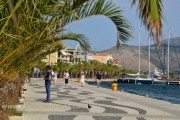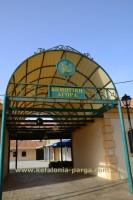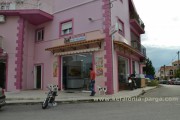Since 1757,
Argostoli is the capital of the island of
Kefalonia. It is the largest town and main port of the island. With its loose nice houses, Argostoli flows down to the shallow lagoon Koutavos, which is part of the Gulf called Argostoli. Mighty eucalyptus trees surround the lagoon as if giant guards.
You will be impressed by the capital waterfront surrounded by palm trees and artistically decorated with tiles, on the surface of which the waves of the blue bay as if continue their slow running. Early in the morning, owners of restaurants and hotels together with local residents flock here to buy fresh fish, which is delivered to the pier by small boats and ships of the fishermen. This kind of fish market is visited by curious turtles Kareta Kareta, attracted by an easy prey in the form of shellfish and small fish that are thrown into the water by compassionate fishermen.
Once, splendid buildings in the Venetian style decorated the town. Unfortunately, Argostoli was almost completely destroyed - what survived the bombing in 1943 was ruined by the strongest earthquake in 1953. Very few buildings remained intact: in the photo, you can see one of them built in 1826 and partially restored. On the site of the old town, a cute town in the Ionian style was built - with long streets, alleys, parks, and a busy port for local ships and ferries of the international lines.
The main life is in full swing at the waterfront: cafés and restaurants beckon with smells of coffee and a variety of seasonings, hotels accept tourists and say goodbye to the departing guests, souvenir shops and stores are trying to attract potential buyers. There is also a small fruit and vegetable market, where nature`s gifts can be purchased cheaper than at a store. Perhaps, we would recommend to go back a bit on the promenade in the direction of the bridge Drapanos to the bus station. Right behind the station, you will see the indoor pavilions selling vegetables, fruits, honey, and olive oil, produced and grown on Kefalonia. In one of the pavilions, you can buy fresh eggs and chicken. Good meat for the barbecue can be purchased at the butcher shop, which is located next to the hospital. It is very simple to get to the shop: driving to the capital from the direction of the Skala and Poros, you must keep to the left at the crossing (the right road goes along the bay). After a few hundred meters, on the right hand, there would be a hospital, in front of it on the left there is a supermarket. It is this alley that you take – the butcher’s shop is right in front of the supermarket.
To find a place for parking in the town is a very big problem and driving in Argostoli is not the most pleasant experience: the locals abandon cars almost anywhere, not bothering to search for an available place, while pedestrians are scurrying between cars. However, the general atmosphere of friendliness helps avoid unnecessary conflicts and, as a rule, both pedestrians and drivers coexist quite peacefully, despite the fact that everything that happens there reminds chaos very much!
In the center, which is located a few hundred meters from the waterfront, there are banks, shops, archaeological and other museums, exhibitions, botanical garden, theater, school, a hospital, and all the attributes of an ordinary town.
Nightlife begins at six o`clock in the evening and lasts until late at night, with its epicenter in the street Lifostroto. Numerous shops and bars in this pedestrian street are inexplicably combined with the churches, in the silence of which the Greeks and visitors come either to light a candle and pray or partake of the local culture. Many cafes have WiFi, which is very convenient, and we always use it, if we need urgently to visit the vast Internet. You will be kindly informed about your password even if you do not want to order anything. The street is also full of souvenir shops, boutiques, and jewelry shops.
As to the prices of goods and groceries as well as meals at restaurants and cafes - Argostoli, perhaps, take the second place after expensive Fiskardo.
Small towns of Kefalonia will offer you the same range at a more reasonable price. For example, at Sala kleftiko will cost you 8.5 Euros and will be of the excellent taste, while in the capital you will have to pay for this meal 5 Euros more and the quality in our opinion leaves much to be desired.
One of the attractions of Argostoli is the Drapanos bridge or the bridge of de Bosset, built in 1813 during the British rule (1809-1864) and designed by the Swiss engineer Charles de Bosset, who served in the British army. Originally, the bridge was made of wood, but in 1842, it was rebuilt using stone as a material. The massive earthquake in 1953 damaged this structure, but it was successfully restored. Near the bridge, there is a stone obelisk bearing the name of Kolona and symbolizing the Greek parliament gratitude to Britain.
A few kilometers from Argostoli, there is an elegant lighthouse of St. Theodore, which was built under the guidance of the British governor. This small round-shaped building with Doric columns, is rightly considered the hallmark of the capital and its image can be seen on posters, calendars, and brochures. There is a picturesque road running along the bay from the capital to the lighthouse.
Make a stop in the town Katavotres - here sea water goes under the ground, forming an underground river that ends in Karavomylos on the other side of the island of Kefalonia, near the port of Sami. Here the river flows into the sea again. The underground lake Melissani is in the way of this current, charming its numerous visitors with the pristine beauty.
The nearest beach - Gradakia beach - is 2 km from the capital town to the west. To get to it, it is not necessary to turn around the Cape. You can take a taxi or walk from Argostoli, if you are not afraid of walking. The beach is small but very nice and picturesque. You will be offered deck chairs and sun umbrellas. There is also a tavern, where you can enjoy good food or drink coffee.
Every half hour from morning until late evening, two small ferries run from Argostoli to Lixouri that is the second largest town of the island. Tickets for the passenger cost 2.5 Euros and for a car - 3.90 Euros. Tickets can be purchased at the terminal before sailing.














